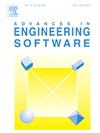基于轻量级卷积神经网络的桥梁路面缺陷检测与导航模型与系统
IF 5.7
2区 工程技术
Q2 COMPUTER SCIENCE, INTERDISCIPLINARY APPLICATIONS
引用次数: 0
摘要
基于更快区域的卷积神经网络(Faster R-CNN)被广泛应用于路面缺陷检测。然而,由于模型规模大,检测速度慢,限制了该方法在该任务中的有效性。为了应对这些挑战,我们开发了两个版本的Faster R-CNN模型——小型和大型。首先,通过整合倒立残差块、深度可分卷积和注意机制对模型进行结构优化,以提高效率和性能。大型版本还集成了多尺度特征提取,以增强检测能力。其次,采用模型剪枝进一步压缩网络;通过广泛的烧蚀实验来研究模型内部结构及其对裂纹检测精度和效率的影响。实验结果表明,该模型在桥梁表面缺陷检测方面优于一般基于cnn的模型,在保持较高精度的同时,检测速度更快。大版本表现出更好的性能,但代价是增加了模型的复杂性。测试是在中国南京一座真实的桥梁上进行的。此外,还部署了一个集成了笔记本电脑和智能手机的软件应用程序来识别缺陷,并绘制出它们在桥上的位置,简化了检测过程。该软件的源代码可在https://github.com/DUYA686686/detection-software.git免费获得本文章由计算机程序翻译,如有差异,请以英文原文为准。
A lightweight convolutional neural network-based model and system for defect detection and navigation on bridge road surface
The Faster Region-based Convolutional Neural Network (Faster R-CNN) is widely used for detecting defects on road surface. However, its effectiveness in this task is limited by its large model size and slow detection speed. To address these challenges, two versions of the Faster R-CNN model—small and large—were developed. First, the models were structurally optimized by integrating inverted residual blocks, depthwise separable convolutions, and attention mechanisms to improve efficiency and performance. The large version also incorporated multi-scale feature extraction for enhanced detection capabilities. Second, model pruning was applied to further compress the networks. Extensive ablation experiments were conducted to investigate the relationship between the model's internal structure and its impact on crack detection accuracy and efficiency. The experimental results demonstrate that the proposed models outperform general CNN-based models in bridge surface defect detection, achieving superior detection speed while maintaining high accuracy. The large version exhibits better performance but at the cost of increased model complexity. Testing was conducted on a real-life bridge in Nanjing, China. Additionally, a software application, integrated with a laptop and a smartphone, was deployed to identify defects and map their locations on the bridge, streamlining the detection process. The source code of this software is freely available at https://github.com/DUYA686686/detection-software.git
求助全文
通过发布文献求助,成功后即可免费获取论文全文。
去求助
来源期刊

Advances in Engineering Software
工程技术-计算机:跨学科应用
CiteScore
7.70
自引率
4.20%
发文量
169
审稿时长
37 days
期刊介绍:
The objective of this journal is to communicate recent and projected advances in computer-based engineering techniques. The fields covered include mechanical, aerospace, civil and environmental engineering, with an emphasis on research and development leading to practical problem-solving.
The scope of the journal includes:
• Innovative computational strategies and numerical algorithms for large-scale engineering problems
• Analysis and simulation techniques and systems
• Model and mesh generation
• Control of the accuracy, stability and efficiency of computational process
• Exploitation of new computing environments (eg distributed hetergeneous and collaborative computing)
• Advanced visualization techniques, virtual environments and prototyping
• Applications of AI, knowledge-based systems, computational intelligence, including fuzzy logic, neural networks and evolutionary computations
• Application of object-oriented technology to engineering problems
• Intelligent human computer interfaces
• Design automation, multidisciplinary design and optimization
• CAD, CAE and integrated process and product development systems
• Quality and reliability.
 求助内容:
求助内容: 应助结果提醒方式:
应助结果提醒方式:


